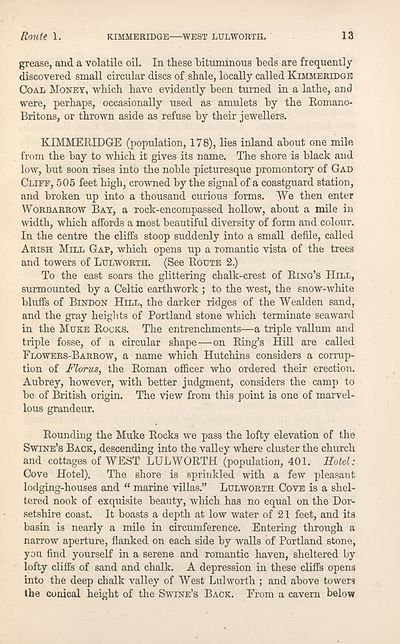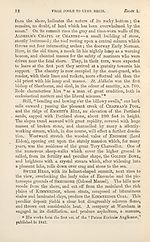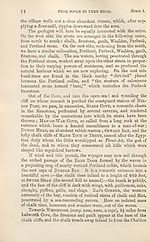Download files
Complete book:
Individual page:
Thumbnail gallery: Grid view | List view

Route 1.
KIMMERIDGE WEST LULWORTK.
13
grease, and a volatile oil. In these bituminous beds are frequently
discovered small circular discs of . shale, locally called Kimmeridge
Coal Monet, which have evidently been turned in a lathe, and
were, perhaps, occasionally used as amulets by the Romano*
Britons, or thrown aside as refuse by their jewellers.
KIMMERIDGE (population, 178), lies inland about one mile
from the bay to which it gives its name. The shore is black and
low, but soon rises into the noble picturesque promontory of Gad
Cliff, 505 feet high, crowned by the signal of a coastguard station,
and broken up into a thousand curious forms. We then enter
Worbarrow Bat, a rock-encompassed hollow, about a mile in
width, which affords a most beautiful diversity of form and colour.
In the centre the cliffs stoop suddenly into a small defile, called
Arish Mill Gap, which opens up a romantic vista of the trees
and towers of Lulworth. (See Route 2.)
To the east soars the glittering chalk-crest of Ring’s Hill,
surmounted by a Celtic earthwork ; to the west, the snow-white
bluffs of Bindon Hill, the darker ridges of the Wealden sand,
and the gray heights of Portland stone which terminate seaward
in the Muke Rooks. The entrenchments—a triple vallum and
triple fosse, of a circular shape—on Ring’s Hill are called
Flowers-Barrow, a name which Hutchins considers a corrup¬
tion of Floras, the Roman officer who ordered their erection.
Aubrey, however, with better judgment, considers the camp to
be of British origin. The view from this point is one of marvel¬
lous grandeur.
Rounding the Muke Rocks we pass the lofty elevation of the
Swine’s Back, descending into the valley where cluster the church
and cottages of WEST LULWORTH (population, 401. Hotel:
Cove Hotel). The shore is sprinkled with a few pleasant
lodging-houses and “marine villas.” Lulworth Cove is a shel¬
tered nook of exquisite beauty, which has no equal on the Dor¬
setshire coast. It boasts a depth at low water of 21 feet, and its
basin is nearly a mile in circumference. Entering through a
narrow aperture, flanked on each side by walls of Portland stone,
you find yourself in a serene and romantic haven, sheltered by
lofty cliffs of sand and chalk. A depression in these cliffs opens
into the deep chalk valley of West Lulworth ; and above towers
the conical height of the Swine’s Back. From a cavern below
KIMMERIDGE WEST LULWORTK.
13
grease, and a volatile oil. In these bituminous beds are frequently
discovered small circular discs of . shale, locally called Kimmeridge
Coal Monet, which have evidently been turned in a lathe, and
were, perhaps, occasionally used as amulets by the Romano*
Britons, or thrown aside as refuse by their jewellers.
KIMMERIDGE (population, 178), lies inland about one mile
from the bay to which it gives its name. The shore is black and
low, but soon rises into the noble picturesque promontory of Gad
Cliff, 505 feet high, crowned by the signal of a coastguard station,
and broken up into a thousand curious forms. We then enter
Worbarrow Bat, a rock-encompassed hollow, about a mile in
width, which affords a most beautiful diversity of form and colour.
In the centre the cliffs stoop suddenly into a small defile, called
Arish Mill Gap, which opens up a romantic vista of the trees
and towers of Lulworth. (See Route 2.)
To the east soars the glittering chalk-crest of Ring’s Hill,
surmounted by a Celtic earthwork ; to the west, the snow-white
bluffs of Bindon Hill, the darker ridges of the Wealden sand,
and the gray heights of Portland stone which terminate seaward
in the Muke Rooks. The entrenchments—a triple vallum and
triple fosse, of a circular shape—on Ring’s Hill are called
Flowers-Barrow, a name which Hutchins considers a corrup¬
tion of Floras, the Roman officer who ordered their erection.
Aubrey, however, with better judgment, considers the camp to
be of British origin. The view from this point is one of marvel¬
lous grandeur.
Rounding the Muke Rocks we pass the lofty elevation of the
Swine’s Back, descending into the valley where cluster the church
and cottages of WEST LULWORTH (population, 401. Hotel:
Cove Hotel). The shore is sprinkled with a few pleasant
lodging-houses and “marine villas.” Lulworth Cove is a shel¬
tered nook of exquisite beauty, which has no equal on the Dor¬
setshire coast. It boasts a depth at low water of 21 feet, and its
basin is nearly a mile in circumference. Entering through a
narrow aperture, flanked on each side by walls of Portland stone,
you find yourself in a serene and romantic haven, sheltered by
lofty cliffs of sand and chalk. A depression in these cliffs opens
into the deep chalk valley of West Lulworth ; and above towers
the conical height of the Swine’s Back. From a cavern below
Set display mode to:
![]() Universal Viewer |
Universal Viewer | ![]() Mirador |
Large image | Transcription
Mirador |
Large image | Transcription
| Antiquarian books of Scotland > Adventure and adventurers > Black's guide to the counties of Dorset, Devon, & Cornwall > (33) |
|---|
| Permanent URL | https://digital.nls.uk/142586774 |
|---|
| Description | Thousands of printed books from the Antiquarian Books of Scotland collection which dates from 1641 to the 1980s. The collection consists of 14,800 books which were published in Scotland or have a Scottish connection, e.g. through the author, printer or owner. Subjects covered include sport, education, diseases, adventure, occupations, Jacobites, politics and religion. Among the 29 languages represented are English, Gaelic, Italian, French, Russian and Swedish. |
|---|

